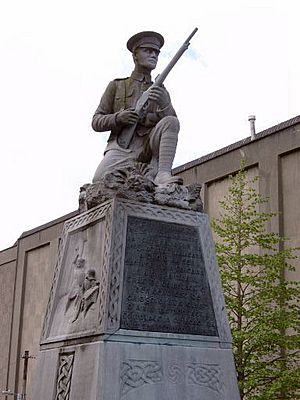Irish War of Independence facts for kids
Quick facts for kids Irish War of Independence |
|||||||||
|---|---|---|---|---|---|---|---|---|---|
| Part of the Irish revolutionary period | |||||||||
 Monument to IRA fighters in Phibsborough, Dublin |
|||||||||
|
|||||||||
| Belligerents | |||||||||
| Commanders and leaders | |||||||||
Military commanders:
|
Military commanders:
|
||||||||
| Units involved | |||||||||
| Irish Republican Army |
|
||||||||
| Strength | |||||||||
| c. 15,000 IRA members | Total: c. 42,100
|
||||||||
| Casualties and losses | |||||||||
| 491 dead | 936 dead
|
||||||||
|
|||||||||
The Irish War of Independence was a fight for freedom. It happened when the Irish Republican Army (IRA) fought against British soldiers. The British wanted to keep Ireland under their control.
This war took place between 1919 and July 1921. The fighting stopped so that a peace treaty could be discussed and agreed upon.
Contents
Why the Conflict Started
For many years, starting in the 1870s, many Irish people wanted to govern themselves. This idea was called "Home Rule." They wanted Ireland to have its own government, but still be part of the British Empire. Groups like the Irish Parliamentary Party (IPP) pushed for this.
A smaller group, led by Arthur Griffith and his Sinn Féin party, wanted Ireland to be completely independent right away.
In 1914, the British Parliament passed a law for Home Rule. But then the First World War started, and the law was put on hold. Most Irish people supported Britain in the war, hoping Home Rule would happen afterward. However, some Irish Volunteers did not want Ireland to be involved in the war.
This led to a split in the Volunteer movement. A group called the Irish Republican Brotherhood secretly began planning a rebellion against British rule in Ireland.
The Easter Rising
The plan for a rebellion happened during the Easter Rising in 1916. The Irish Volunteers launched an uprising to end British rule. They announced that Ireland was now an independent republic.
The Rising mostly took place in Dublin and lasted about a week. Over 400 people died. The British quickly stopped the rebellion. They executed the leaders and arrested thousands of Irish activists. This made many Irish people very angry and turned them against British rule.
How the War Happened
After the Easter Rising, many Irish people became "Republicans." This meant they wanted Ireland to be a republic, completely free from Britain. Republicans lived all over Ireland. However, in some parts of Ulster, people called "Unionists" lived. Unionists wanted to stay under British control.
In Dublin, the political party Sinn Féin won most of the seats in the Irish Dáil (which was like their own parliament). They then created the IRA (Irish Republican Army). The IRA's goal was to fight the British soldiers in Ireland. The British government did not recognize the Dáil and wanted to stop it.
Fighting began in 1919. By 1921, the IRA had become very strong. They had largely defeated the Royal Irish Constabulary (RIC), which was the police force in Ireland. This meant Ireland had very little police presence.
In London, the British government started to disagree about what to do with Ireland. The war continued until 1922. Finally, Irish Sinn Féin leaders and British politicians (called MPs) made a peace treaty.
The treaty created two parts of Ireland. Six of the nine counties in Ulster, where most Unionists lived, remained under British rule. This area became Northern Ireland. The rest of Ireland became its own independent country, called the Irish Free State.
Remembering the War
A special place called the Garden of Remembrance was built in Dublin in 1966. This was 50 years after the Easter Rising. It remembers those who died for Irish freedom.
There is also a National Day of Commemoration. On this day, all Irish men and women who fought in wars are remembered.
The very last person who fought in the Irish War of Independence was Dan Keating. He was a member of the IRA and passed away in October 2007 at 105 years old.
Images for kids
-
West Connemara IRA flying column (a small, fast-moving group of soldiers)
-
A group of "Black and Tans" and Auxiliaries (special British police forces) in Dublin, April 1921
-
The funeral of Michael Collins at St. Mary's Pro-Cathedral, Dublin, August 1922
-
Catholic-owned businesses in Lisburn destroyed by loyalists in August 1920.
-
Monument to IRA fighters in Phibsborough, Dublin
-
Constance Markievicz was a member of the Irish Citizen Army and fought in the Easter Rising. In 1919 she became the Minister for Labour in the Irish Republic's government.
See also
 In Spanish: Guerra de Independencia Irlandesa para niños
In Spanish: Guerra de Independencia Irlandesa para niños




















